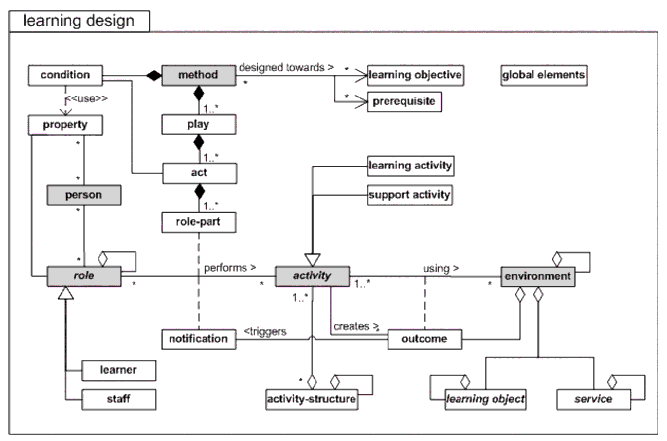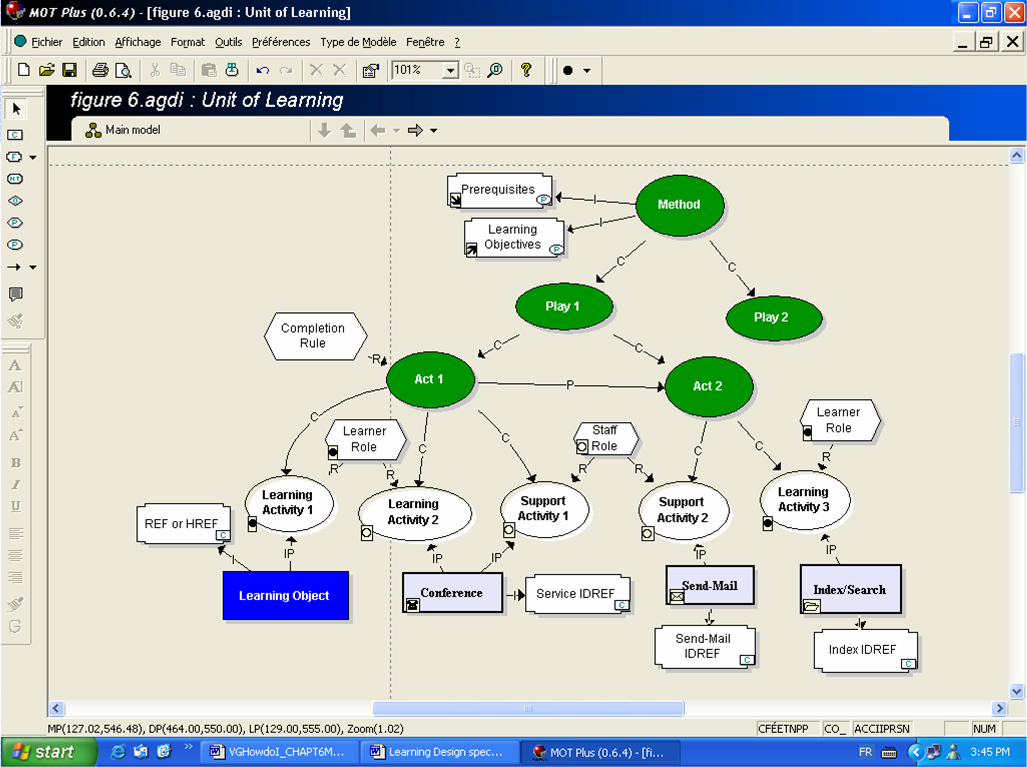IMS Learning Design: Difference between revisions
Jump to navigation
Jump to search
(→Links) |
|||
| Line 21: | Line 21: | ||
:For instance, a teacher may be notified by email that an assignment has been submitted and needs marking; once the score has been posted, the learner may be notified to undertake a new activity according to the result.}} | :For instance, a teacher may be notified by email that an assignment has been submitted and needs marking; once the score has been posted, the learner may be notified to undertake a new activity according to the result.}} | ||
=== An overall view === | |||
An official [[UML]] Diagram summarizes the LD modelling language: | |||
[[Image:imsld_infov1p03.gif|frame|none|UML diagram of IMS Learning Design]] | |||
An easier to understand picture has been made by Gilbert Paquette and/or Michel Léonard as an example ontology for their [[MOTPlus]] authoring tool: | |||
[[Image:LD-explained-in-MOT.png|frame|none|IMS Learning Design as MOTPlus concept map, by Gilbert Paquette and Michel Léonard]] | |||
== Links == | == Links == | ||
Revision as of 18:21, 11 December 2006
Definition
- IMS Learning Design is a formal pedagogical standard, a (educational modeling language) to describe technology supported pedagogical scenarios based on rich instructional design models.
- IMS Learning Design as opposed to IMS Simple Sequencing/SCORM focuses on the organization of learning activities.
- LD has evolved from Educational Markup Language (EML).
Conceptual Structure of the Learning Design
A level architecture
According to the CETIS Briefing on Learning Design:
- Level A contains the core of IMS Learning Design: people, activities and resources, and their coordination through the method, play, act and role-parts elements. This simply provides for a series of time ordered learning activities to be performed by learners and teachers, using learning objects and/or services.
- Level B adds greater control and complexity through the use of properties and conditions.
- Properties may be internal (local) or external (global). They are used to store information about a person, such as test results or learner preferences; a role, such as whether the role is for a full-time or part-time learner; or a learning design itself. Internal properties persist only during a single run of a learning design, while external properties retain their values beyond the end of a run, and can be accessed from different runs and/or different learning designs.
- Level C offers the opportunity for more sophisticated learning designs through notifications (messaging), which allow for notification of new activities to be triggered automatically in response to events in the learning process. It enables the automation of learning flow activities, which are triggered by the completion of tasks, rather than the learning flows being pre-planned.
- For instance, a teacher may be notified by email that an assignment has been submitted and needs marking; once the score has been posted, the learner may be notified to undertake a new activity according to the result.
An overall view
An official UML Diagram summarizes the LD modelling language:
An easier to understand picture has been made by Gilbert Paquette and/or Michel Léonard as an example ontology for their MOTPlus authoring tool:
Links
Examples
- Examples by title in OU's DSpace Server (probably the best example site)
Introductions and presentations
- La nome learning design, slides (by DSchneider)
Software
Software indexes
Editors
- Reload LD editor and player. The Learning Design Editor (based on the IMS Learning Design specifications) allows the creation of re-usable "Pedagogical Templates" allowing the user to define a set of Learning Objectives, Activities and Learning Environments. These templates can be re-purposed with the user's own content to create on-line Learning Design compliant resources.
- Free, Java 1.5/Eclipse based, cross-platform (downloads are fairly large between 20 and 50 MB for the Java-less versions).
- Supports Levels A,B,C
- Reload Editor 2.5.2 (und up) now also supports Learning Design. It also supports IEEE LOM, IMS MD 1.2.4, IMS CP 1.1.4 and SCORM 2004 (thus simple sequencing) and IMS LD level A. Documentation for the LD part of the editor was not found when tested and installed on 12:54, 4 December 2006 (MET).
- MOT+ The editor from the MISA method (does LD level A). Note: This editor is free for non-commercial use (but difficult to find).
On-line Scenario Editors
- DialogPlus Toolkit. This guidance toolkit is being developed, as part of the JISC/NSF funded DialogPlus project, to guide and support
teachers as they create, modify, and share learning activities and resources. It can export to IMS Learning Design (which level ?).
Servers
- LAMS (not LD, but close).
- Gridcole (article that describes the system)
Links
- Learningnetworks (best news site as of July 2006)
- Unfold Best site for resources
References
- Caeiro-Rodríguez, Manuel; Martín Llamas-Nistal and Luis Anido-Rifón (2005). Towards a Benchmark for the Evaluation of LD Expressiveness and Suitability. Journal of Interactive Media in Education, 2005/04. ISSN:1365-893X jime.open.ac.uk/2005/04.
- de la Teja, Ileana; Karin Lundgren-Cayrol and Gilbert Paquette (2005). Transposing MISA Learning Scenarios into IMS Units of Learning. Journal of Interactive Media in Education (Advances in Learning Design. Special Issue, eds. Colin Tattersall, Rob Koper), 2005/13. ISSN:1365-893X jime.open.ac.uk/2005/13.
- Dessus, Philippe et Schneider, Daniel Scénarisation de l'enseignement et contraintes de la situation, In J.-P. Pernin & H. Godinet (2006). (Eds.), Colloque Scénariser l'enseignement et l'apprentissage : une nouvelle compétence pour le praticien ? (pp. 13-18). Lyon : INRP. PDF
- Karen Fill, Samuel Leung, David DiBiase and Andy Nelson (2006). Repurposing a learning activity on academic integrity: the experience of three universities. Journal of Interactive Media in Education, 2006/01. ISSN:1365-893X jime.open.ac.uk/2006/01.
- Conole, Gráinne and Karen Fill (2005). A learning design toolkit to create pedagogically effective learning activities. Journal of Interactive Media in Education (Advances in Learning Design. Special Issue, eds. Colin Tattersall, Rob Koper), 2005/08. ISSN:1365-893X Abstract (PDF/HTML open access)
- Greller, Wolfgang (2005). Managing IMS Learning Design. Journal of Interactive Media in Education (Advances in Learning Design. Special Issue, eds. Colin Tattersall, Rob Koper), 2005/12. ISSN:1365-893X jime.open.ac.uk/2005/12.
- Jeffery, Ann and Sarah Carrir (2003). What Is IMS Learning Design ?, CETIS Brief, CETIS Briefing on Learning Design PDF.
- Miao, Y., Hoeksema, K.,Hoppe, H.U., Harrer, A.(2005). CSCL Scripts: Modelling Features and Potential Use. In Proceedings of the International Conference on Computer Supported Collaborative Learning (CSCL2005), Taiwan, June 2005. PDF
- Milligan, Colin D. ; Phillip Beauvoir and Paul Sharples (2005). The Reload Learning Design Tools. Journal of Interactive Media in Education (Advances in Learning Design. Special Issue, eds. Colin Tattersall, Rob Koper), 2005/07. ISSN:1365-893X. jime.open.ac.uk/2005/07.
- Tattersall, Colin & Rob Koper (2005). Advances in Learning Design, Jurnal of Interactive Media in Education, 2005/01. ISSN:1365-893X jime.open.ac.uk/2005/01 (HTML).

